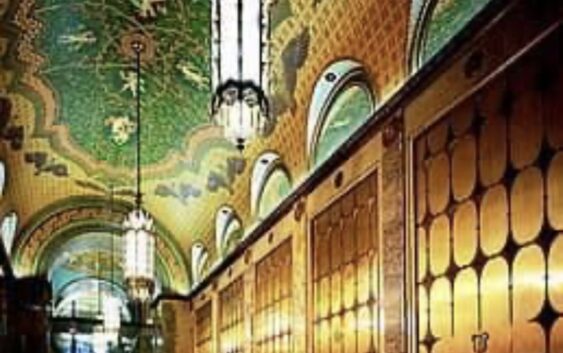The Fisher Building: Art Deco Building Still Reigns Majestically in Detroit!

The Fisher Building: Art Deco Building Still Reigns Majestically in Detroit!
Art Deco Buildings Still Well Preserved in Detroit
THE FISHER BUILDING, DETROIT
The building known as “Detroit’s largest art object” has been dropping jaws in New Center for nearly a century.
The Fisher — built by the Fisher brothers of “Body by Fisher” fame — opened in September 1928, at Second Avenue and Grand Boulevard. Once known as the Cathedral to Commerce, the 441-foot tower is decked to the nines in fancy marbles, mosaics, soaring, painted ceilings and a whole lot of brass and bronze. This world of shops, theater, art and architectural beauty is renowned architect Albert Kahn’s masterpiece, “a superbly designed complex which displays some of the finest craftsmanship in any Art Deco style building constructed in the U.S. in the 1920s,” the National Park Service says.
Unquestionably, the golden tower of the Fisher Building is one of the most recognizable sights in Detroit’s skyline.
Like so much of Detroit’s history, the Fisher Building is tied to the automobile industry. The Fisher brothers -– Frederick J., Charles T., William A., Lawrence P., Edward F., Alfred J. and Howard A. -– made a fortune making auto bodies for Detroit’s booming car industry. From the days in their boyhood home in Norwalk, Ohio, the brothers learned from their parents -– carriage maker Lawrence Sr. and Margaret -– to work and play together, a mentality of one for all and all for one. Their bond was strong. They arrived in Detroit in 1908 and formed the Fisher Body Co. Their timing was impeccable: Their business was founded just three months before the birth of General Motors Corp.
They were responsible for creating the closed body chassis for Cadillac in 1910. This development not only transformed the automobile from a pleasure vehicle into the indispensable, world-changing, all-weather, year-round form of transportation it is today, it also transformed the brothers into filthy rich businessmen. They had started the business with $50,000 (about $1.2 million today), and GM bought them out just 18 years later, in 1926, for $208 million (a staggering $2.5 billion today). The brothers also introduced the first four-door sedan bodies. They sold 60% interest in their company to GM — giving Fisher exclusive supplier status -– in 1919, and the rest of the 40% in 1925, for a reputed $208 million. They made large investments in oil, railroad and aviation equipment, banking and real estate.
But unlike many Detroit millionaires of today, the Fisher brothers often used their wealth to better the city and its people. They gave millions to countless charities, civic causes, churches, educational institutions, and to making Detroit one of the finest cities in the world.
To that end, the Fishers commissioned Kahn in 1927 and essentially told him to go wild. Simply put, the Detroit News wrote in 2001, the brothers told the architect to build them “the most beautiful building in the world” and that quality would not be sacrificed in order to save money. It was an architect’s dream project.
The brothers wanted more than just an office tower to serve as the company’s headquarters, they wanted the building to also serve as a center for shopping and entertainment. The brothers did not plan on profiting from the building, rather they viewed it as a gift to Detroit. A Free Press headline in January 1927 referred to it as the brothers’ “huge testimonial to their faith in Detroit.”
Or, as the Michigan Manufacturer and Financial Record simply put it in October 1928, the Fisher is a building “into the making of which money has been literally flung with a generous hand, not merely for the sake of spending it, but to gratify the desire of the owners to give such an example of architectural and cultural elegance as will constitute an outstanding claim to its permanent inclusion in the list of the most important structures of the country.”
The ornate 30-story building, completed in 1928, is one of the major works of architect Albert Kahn, and is designed in an Art Deco style, faced with limestone, granite, and several types of marble. The Fisher family financed the building with proceeds from the sale of Fisher Body to General Motors. It was designed to house office and retail space.
The building, which contains the elaborate 2,089-seat Fisher Theatre, was designated a National Historic Landmark on June 29, 1989. It also houses the headquarters for the Detroit Public Schools and the studios of radio stations WJR, WDVD, and WDRQ.























